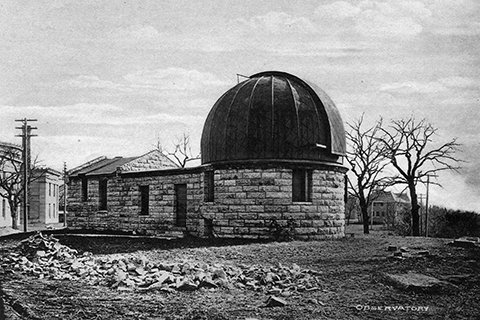Retrospect: Reaching for the Stars

Written by Silva Young
For more than 50 years, public viewings at the Tate Observatory have delighted stargazers every Friday night during the fall and spring semesters. The evening begins with graduate students giving talks on comets, planetary orbits, supernovas, black holes, and more. After a few minutes of questions and answers, the group is led into a copper-green rooftop dome where they can gaze at the sky through the lens of a 120-year-old telescope.
It’s one way the University of Minnesota’s Institute for Astrophysics (MIfA) has been bringing astronomy to the public and capturing the imagination of future scientists.
Those who have visited the observatory can view the sky through a huge black telescope that points upward like a cannon barrel. Those who haven’t visited will have to wait a bit longer. The telescope has been safely secured, wrapped in plastic, while the historic Tate Laboratory of Physics undergoes a $92.5 million renovation.
“While the telescope was never used for any groundbreaking research, it does bring people to the University, it gets them interested in science, and, most of all, it is a priceless antique,” said CSE professor of astronomy Terry Jones.
Looking forward and upward
The telescope was built by Warner & Swasey Company of Cleveland, Ohio in 1896, and the 10.5-inch, hand-ground double lens was made by John A. Brashear Company of Allegheny, Penn. Brashear was a Pittsburgh astronomer and instrument builder who gained worldwide respect with his optical elements and precision instruments. Nearly every observatory at the time purchased Brashear instruments for science and industry for their quality.
“In the late 1800s, if you were a university of any note, or aspired to be, you had an observatory and telescope,” Jones said. “Ours is in very good shape.”
As early as 1879, University officials discussed the need for a working observatory to instruct students, to stimulate science interest, and to contribute to astronomical knowledge. Yet, it would be 1894 before University President Cyrus Northrop recommended that the Minnesota Legislature make a $10,000 appropriation for an observatory and telescope.
The 500-lb. telescope finally arrived on campus in 1897 at a cost of $6,800. It was installed in an observatory located near the Mississippi River bank behind Coffman Memorial Union. Francis P. Leavenworth, a professor of astronomy, was named the first director of the observatory and served until 1927.
Leavenworth used the telescope extensively to study double or variable stars (which include Polaris and the North Star), research that was important for the insight it provided into the mass of stars and basic questions of astrophysics.
“Making these observations were important, if for no other reason than they were recordings of phenomena that were not greatly understood at the time,” Jones said.
By the late 1920s, an alternative location was needed to house the telescope because of increasing light pollution from downtown Minneapolis.
The University Board of Regents applied for a Public Works Administration (PWA) grant in January 1937 to construct an Astronomical Observatory on top of the Tate Lab of Physics, which was completed in 1926. The cost was estimated at $14,273 and was designed by C. H. Johnston, who designed a number of University of Minnesota buildings.
In June 1938, the University accepted a PWA grant of $6,422, completed the observatory, and moved the telescope to its current location on top of Tate at the end of 1938.
Friday night lights
Friday night viewings at Tate have been ongoing since the 1960s, and have grown in popularity over recent years. “According to some reports, crowds as large as 100 people were in attendance last year,” said Melanie Beck, public outreach coordinator and astrophysics graduate student.
With responsibility for MIfA’s general outreach programs, Beck says that they have coordinated activities for about 70 groups over the past three academic years.
“The majority have been elementary and middle schools, followed by Boy Scout and Girl Scout troops, Rotary clubs, Lions clubs, and astronomy hobby clubs,” Beck said. “We also participate in the College of Science and Engineering’s booth at the Minnesota State Fair.”
In addition to hosting a series of public lectures throughout the year, the MIfA offers Universe in the Park, an outreach program funded by the National Science Foundation. The presentations, which are held in Minnesota area state and local parks on summer weekends, cover a variety of topics, followed by telescope viewings.
“Promoting science is awesome and making a complicated topic understandable for younger generations is a great way to engage students and hopefully encourage them to pursue a STEM field themselves,” Beck said. “I love when people see Saturn’s rings for the first time. There’s not much more awe-inspiring than that.”
Although Friday night viewings at the Tate observatory are discontinued until renovations on Tate are complete in 2017, the MIfA has teamed up with the University’s Bell Museum. Stargazers can hear presentations on astronomical topics followed by outdoor telescope observing on the first Wednesday of each month. Visit the Bell Museum After Hours program at z.umn.edu/stargazers to learn more.
